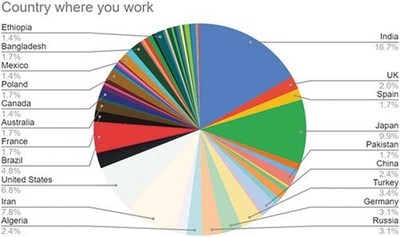- Scientists' research activities reveals how the materials science community showed resilience and adaption, yet highlights that doctoral students were hit relatively hard by lockdown measures
TSUKUBA, Japan, April 28, 2021 /PRNewswire/ -- More than one year since the beginning of the COVID-19 outbreak, the pandemic continues to affect daily life almost everywhere in the world. Since Spring 2020, lockdown conditions have become the norm in many countries, and many employees have switched to working from home on a quasi-permanent basis. However, in certain professional sectors, teleworking is only partly possible, if at all, and often not efficient - as is the case for academia and scientific research. Now, Adarsh Sandhu from the University of Electro-Communications, Japan, and colleagues have investigated how the COVID-19 pandemic affected the research activities of materials scientists between its onset in early Spring 2020 and the general relaxation of lockdown restrictions in early Autumn 2020.

Sandhu and colleagues carried out an extensive global survey, consisting of a questionnaire sent to more than 30,000 materials scientists all over the world. The questionnaire was sent on 9 October 2020, with a reply period of two weeks. The questions addressed how scientists were affected between Spring 2020 and late September 2020. Around 380 scientists from 35 countries provided feedback. In addition, Sandhu and colleagues also conducted a series of interviews with 10 eminent professors in materials science; these took place between late May 2020 and early December 2020 (and are freely accessible as 'STAM Podcasts').
An analysis of the responses showed that the majority of research institutes was not prepared for the COVID-19 crisis, with less than half having a contingency plan in place. During the first lockdown phase, unsurprisingly, 89% of respondents switched to teleconferencing as their main communication tool. Teleconferencing was found to lead to fatigue (36%), however, and the lack of (normal) interactions with colleagues caused feelings of isolation for 40% of respondents. Materials scientists started to attend virtual conferences (64%), but more than 25% of respondents "disagreed" or "strongly disagreed" that these are an effective way to interact with colleagues.
The survey also showed that many scientists used the lockdown time to finish writing papers or research proposals and reading the literature. Several respondents wrote that the pandemic made them consider changing research area. "Meeting people" was almost unanimously deemed the most missed aspect of research activities during lockdown. Finally, the survey also revealed that doctoral students became concerned about completing their PhD on time, or at all, and whether their career prospects are affected.
The interviews with materials science professors from various parts of the world, held at various times during the first lockdown period, showed how the situation differed for different regions and during different phases of the pandemic. The conversations offer personal reflections of how the restrictions forced scientists to rethink how to do research and teach - and also led to the suggestion of establishing robot-based hubs for performing chemical synthesis tasks remotely.
Sandhu and colleagues plan to conduct a follow-up survey later this year, to update their findings. Indeed, mass vaccinations are now well underway on a global level, but the pandemic is far from over. Quoting the authors: "As the world moves into 2021, we want to continue collate and share the experiences of scientists in the materials science community."
Reference
Adarsh Sandhu, Roland Hany, Atsufumi Hirohata, Shunichi Hishita, Ken Kimlicka, Masanobu Naito and Chikashi Nishimura, Science and Technology of Advanced Materials, 22, 173-184 (2021).
https://doi.org/10.1080/14686996.2021.1894756
STAM Podcasts
- The STAM Podcast: Apple Podcast; [cited 2020 Jul 1]. Available from: https://podcasts.apple.com/podcast/the-stam-podcast/id1517265384
- The STAM Podcast: Google Podcast; [cited 2020 Jul 1]. Available from: https://podcasts.google.com/feed/aHR0cHM6Ly9mZWVkcy5idXp6c3Byb3V0LmNvbS8xMTQ1MzA2LnJzcw==
- The STAM Podcast: Spotify; [cited 2020 Jul 1]. Available from: https://open.spotify.com/show/2Bvq6MfcqVcckkP4PMLXv7
Contact: sandhu@uec.ac.jp
Chart showing questionnaire respondent's locations of work.
Further information about press release:
Science and Technology of Advanced Materials (STAM), Headquarter Office, National Institute for Materials Science (NIMS)
Address: 1-2-1 Sengen, Tsukuba 305-0047
EMAIL: stam-info@ml.nims.go.jp
About NIMS and STAM
NIMS and Empa have jointed efforts to develop a flagship journal that provides highly-quality information on recent developments in materials science within an open access platform. The collaboration will strengthen the position of STAM in Europe.
Photo: https://mma.prnewswire.com/media/1498612/FIG_1.jpg


